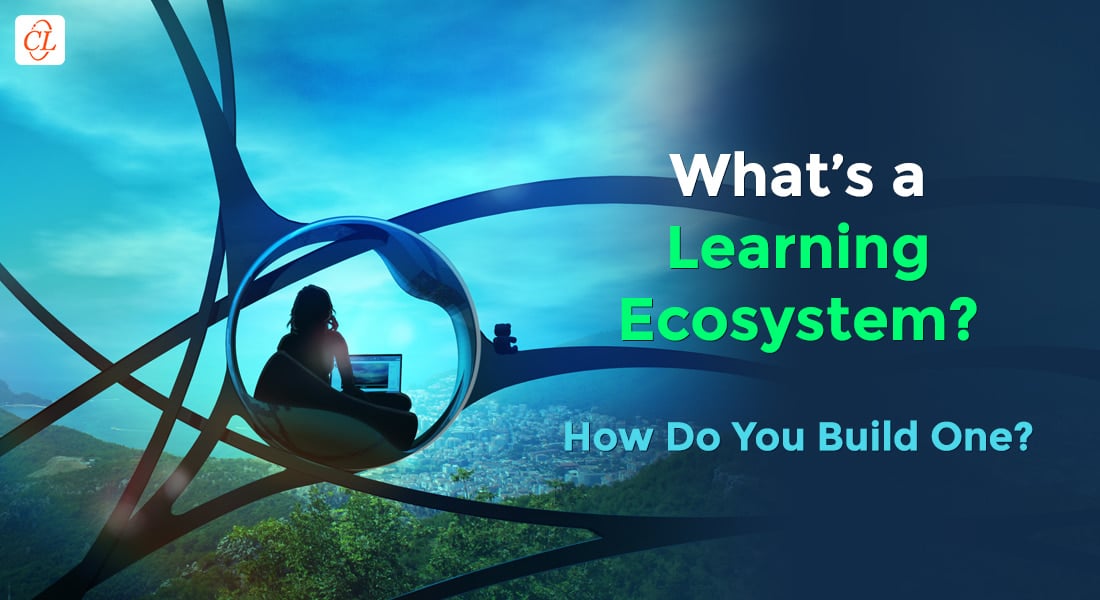4 Practical Tips to Build an Effective Learning Ecosystem in Corporate Training

If you frequently tune into the social commentary of the eLearning industry, you might have come across the phrase, Learning Ecosystem. If you don’t know what it means, then know that it could be the very key that unlocks the secrets to effective corporate training in the new normal. However, before we dive in, let’s create the context.
Every organization in the post-pandemic digital age is looking to strengthen its competitive advantage. However, before leaders can meet their business goals, they need to equip their teams with the tools, technologies, and knowledge needed to fuel and sustain their growth.
A Beginner’s Guide to the Learning Ecosystem
Do you know who your stakeholders are?
- Organization-wide Employees
- Content
- Technology
- Learning culture
Read on to explore tips to build a learning ecosystem!
Central to any cultural shift or performance transition is the comprehension and acceptance of learning that it isn’t something that happens by chance; it requires work and persistence.
Instead of forcing employees to attend a live session or complete an eLearning course, create a situation that encourages them to improve their engagement, participation, and understanding. This helps to build the learning ecosystem.
So, if you’re intrigued by this thought-provoking concept, then keep reading. We’ll discuss everything you need to know about the learning ecosystem, including its importance and tips to increase its effectiveness.
Defining a Learning Ecosystem
Just like an ecosystem comprises different animal and plant species interacting with each other to create a connected system in the wild, a learning ecosystem encompasses diverse people and factors working together to enable and improve learning.
Explore what forward-thinking organizations are implementing to spruce up corporate training!
However, like a natural ecosystem, a learning ecosystem can be healthy, sick, endangered, or self-sustaining. To achieve your corporate training goals, you need to understand the elements that comprise the learning ecosystem and forces both internal and external that shape it.
Forces that Shape the Learning Ecosystem
1. People
Your learners are the key to your learning ecosystem. However, the people you want to upskill or reskill aren’t the only ones impacting the learning ecosystem. You need to consider everyone involved in the training process, including:
- L&D Professionals
- Instructors
- Managers and Team Leaders
- Senior Management
- Third-Party Internal and External SMEs
- Your Company’s Target Learners (Online/Offline)
- Friends and Family
- Support Staff (IT/HR)
Organizations have proper control over what they want their L&D team and instructors to impart in the training. And everyone involved in the training scenario plays a crucial role in setting the tone. For instance, managers provide mentorship. Creative teams help create microlearning videos. HR teams update compliance and policy development process.
2. Content
This is the next major element of a learning ecosystem. It involves L&D professionals working on developing a training strategy that includes the:
- Type of content (videos, courses, infographics)
- Delivery medium (VILT session, LMS, live classroom)
- Assessment methods (quizzes, exams, scenarios, simulations)
The learning ecosystem also focuses on the content, including conversations, interactions, and general knowledge exchange. Also, training might involve the procurement of external alternatives for the content, medium, and assessment method. For instance, you might send your team for training to a new location, such as a shop floor or workshop at a partner organization.
3. Technology
Following the rapid transformation of the eLearning industry, technology has become an essential element of the modern learning ecosystem. Today, you can find hundreds of tools and software in the market for corporate training, from authoring tools like Adobe Captivate and Lectora Inspire to VILT software, like Zoom, Google Meet, and Webex to help you design and deliver training.
L&D professionals leverage the power of these solutions to expedite the learning curve and enable blended learning solutions for better outcomes. These tools play a crucial role in designing assessments and evaluations of training effectiveness, because they allow companies to determine their teams’ progress and training ROI.
4. Learning Culture
The learning culture in an organization refers to the environment, tone, and background that tells people what to expect from corporate training programs. This is one of the most important elements of a learning ecosystem, as it determines whether it’s healthy and thriving or sick and unproductive.
5. Strategy
Strategy isn’t just related to training development and delivery. It also involves the leaderships’ decision-making process that provides their organizations with strategic goals centered around its vision and mission.
The Importance of Building a Learning Ecosystem for Corporate Training
No matter how experienced or talented your employees are, they perform much better if they’re open to learn and grow at work. The better they are at what they do, the more their organization benefits from their input.
Ever since the COVID-19 pandemic began, companies have faced an unprecedented storm of challenges that they need to future-proof their businesses and prepare their employees for potential opportunities and threats.
4 Tips to Build an Effective Learning Ecosystem in Corporate Training
Now that you understand the basics and importance of a learning ecosystem, it’s time to dive into the heart of the matter. Let’s learn how to build an effective learning ecosystem. Here are four powerful tips:
1. Proactively Prepare for Unpredictable Challenges
The pandemic has brought about an unprecedented level of change in the business world. So, no matter what industry you’re in, you need to ensure your team adapts to new challenges. The best way to do that is by becoming agile and proactively preparing for future pandemics, closures, and unforeseen crises.
2. Create a Learner-Centric Training Program
Another great way to build an effective learning ecosystem is by putting your employees first. For a long time, organizations rarely used technology to support training. Now, technology has become a core aspect of training programs. However, you can’t meet all your training requirements with one tool or one solution.
Many employees enjoy in-classroom sessions while others prefer self-directed learning. Some want learning to take place at their offices, while others prefer accessing training content anywhere, anytime. Create a blended learning program that encompasses several methods, such as VILT, microlearning, mobile learning, and classroom sessions.
3. Enable Learning Autonomy
An excellent way to build an effective learning ecosystem is to embrace different learning styles. For instance, user-generated content is becoming quite popular these days, with employees taking ownership of their learning. You can help them learn based on their needs and your goals by enabling and encouraging learning autonomy.
You need to get your learners’ support so that it’s no longer an issue down the line.
4. Crowdsource Your Knowledge and Skills Gaps
When you’re dealing with a crisis, you need to prepare for change and keep pace with developments. You need to determine the skills your team needs to overcome challenges and proactively prepare for the future.
If you’re running out of time, you can crowdsource your knowledge and skills gaps to save money and time and protect your business from future damage.
The Bottom Line
These are the foundational concepts to build an effective learning ecosystem. The business landscape is rapidly growing, and organizations need to ensure they’re ready for changes in the corporate training world.
There’s no point in upgrading your IT infrastructure or revamping your business model if you haven’t prepared your team to adapt to change. Creating an agile learning ecosystem is a prerequisite of transformation and it’s the key to future-proofing your business.
For more insights on how L&D can make an impact in today’s business landscape, join LearnFlux! It’s a 3-day webinar for L&D professionals and you can network with peers in the L&D space and craft tomorrow’s learning solutions!





